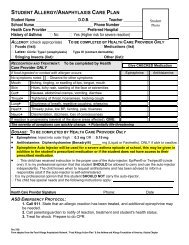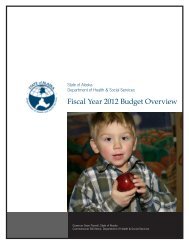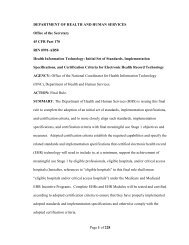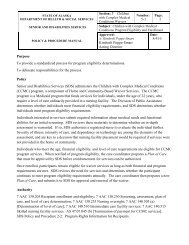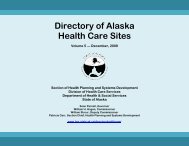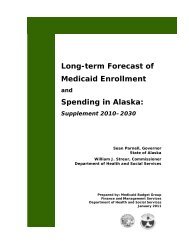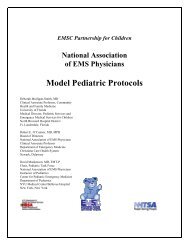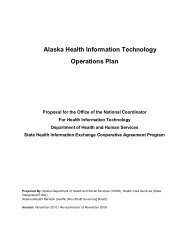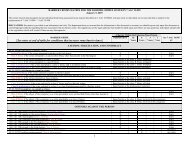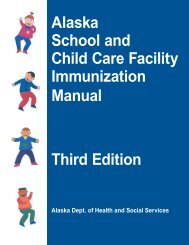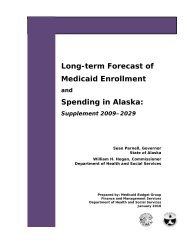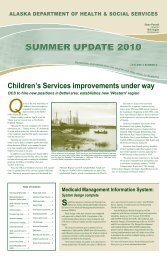Letter dated 02/22/04 to Elder re - U.S. Department of Education
Letter dated 02/22/04 to Elder re - U.S. Department of Education
Letter dated 02/22/04 to Elder re - U.S. Department of Education
Create successful ePaper yourself
Turn your PDF publications into a flip-book with our unique Google optimized e-Paper software.
SIP4TES ON<br />
r<br />
z<br />
Mary <strong>Elder</strong><br />
Executive Di<strong>re</strong>c<strong>to</strong>r<br />
Texas Interagency Council on<br />
Early Childhood Intervention<br />
4900 N. Lamar Boulevard<br />
Austin, Texas 78751-2399<br />
Dear Ms . <strong>Elder</strong> :<br />
UNITED STATES DEPARTMENT OF EDUCATION<br />
OFFICE OF SPECIAL EDUCATION AND REHABILITATIVE SERVICES<br />
F F g 1 1 20,<strong>04</strong><br />
This is in <strong>re</strong>sponse <strong>to</strong> your letter <strong>to</strong> the Office <strong>of</strong> Special <strong>Education</strong> Programs (OSEP) and the<br />
Family Policy Compliance Office (FPCO) <strong>re</strong>questing guidance concerning the disclosu<strong>re</strong> <strong>of</strong><br />
<strong>re</strong>ferral information from a lead agency under Part C <strong>of</strong> the Individuals with Disabilities<br />
<strong>Education</strong> Act (IDEA) <strong>to</strong> the State education agency (SEA) or the local education agency (LEA)<br />
under Part B . The information being disclosed is about child<strong>re</strong>n who will shortly turn th<strong>re</strong>e and<br />
transition from <strong>re</strong>ceiving early intervention services under Part C <strong>to</strong> potentially <strong>re</strong>ceiving special<br />
education and <strong>re</strong>lated services under Part B . You specifically <strong>re</strong>quested on behalf <strong>of</strong> Texas<br />
Interagency Council on Early Childhood Intervention (TXECI), the lead agency in Texas under<br />
Part C, clarification <strong>re</strong>garding the circumstances in which pa<strong>re</strong>ntal consent is <strong>re</strong>qui<strong>re</strong>d for<br />
disclosu<strong>re</strong> <strong>of</strong> this information by the lead agency . OSEP has consulted with the FPCO in<br />
<strong>re</strong>sponding <strong>to</strong> your letter .<br />
The IDEA <strong>re</strong>qui<strong>re</strong>s each State <strong>to</strong> have policies and procedu<strong>re</strong>s <strong>to</strong> ensu<strong>re</strong> a smooth transition for<br />
<strong>to</strong>ddlers <strong>re</strong>ceiving early intervention services under Part C <strong>to</strong> p<strong>re</strong>school or other appropriate<br />
services, including a description <strong>of</strong> how the lead agency will notify the LEA for the a<strong>re</strong>a in<br />
which such a child <strong>re</strong>sides that the child will shortly <strong>re</strong>ach the age <strong>of</strong> eligibility for p<strong>re</strong>school<br />
services under Part B . 20 U .S .C . §1437(a)(8)(A) ; 34 CFR §303 .148 . Section<br />
637(a)(8)(A)(ii)(II) <strong>of</strong> the IDEA also <strong>re</strong>qui<strong>re</strong>s the lead agency <strong>to</strong> convene a confe<strong>re</strong>nce, with the<br />
approval <strong>of</strong> the pa<strong>re</strong>nts <strong>of</strong> the child, among the lead agency, the family, and the LEA at least 90<br />
days (and at the disc<strong>re</strong>tion <strong>of</strong> all such parties, up <strong>to</strong> 6 months) befo<strong>re</strong> the child is eligible for<br />
p<strong>re</strong>school services under Part B, <strong>to</strong> discuss any such services that the child may be eligible <strong>to</strong><br />
<strong>re</strong>ceive .<br />
To help ensu<strong>re</strong> a smooth transition, Cong<strong>re</strong>ss also included specific <strong>re</strong>qui<strong>re</strong>ments under Part B <strong>of</strong><br />
the IDEA for LEAs <strong>re</strong>garding transition <strong>of</strong> child<strong>re</strong>n from Part C <strong>to</strong> Part B . Section 612(a)(9) <strong>of</strong><br />
the IDEA and 34 CFR §300 .132 <strong>re</strong>qui<strong>re</strong> the SEA <strong>to</strong> ensu<strong>re</strong> : that child<strong>re</strong>n served under Part C<br />
who will participate in Part B p<strong>re</strong>school programs experience a smooth and effective transition <strong>to</strong><br />
those p<strong>re</strong>school programs in a manner consistent with section 637(a)(8) <strong>of</strong> the IDEA ; that by the<br />
third birthday <strong>of</strong> a child eligible under Part B, an individualized education program (IEP) or an<br />
individualized family service plan (IFSP) with appropriate content has been developed and is<br />
being implemented for the child ; and that each LEA will participate in transition planning<br />
confe<strong>re</strong>nces arranged by the Part C lead agency .<br />
400 MARYLAND AVE ., SW . . WASHINGTON, D .C . 2<strong>02</strong><strong>02</strong><br />
www . ed . gov<br />
Our mission is <strong>to</strong> ensu<strong>re</strong> equal access <strong>to</strong> education and <strong>to</strong> promote educational excellence throughout the Nation .
Mary <strong>Elder</strong> - Page 2<br />
Additionally, the SEA is <strong>re</strong>sponsible for ensuring that the child find <strong>re</strong>sponsibilities under its<br />
program a<strong>re</strong> met, even if the SEA, through an interagency ag<strong>re</strong>ement or other mechanism,<br />
delegates <strong>to</strong> the lead agency or another agency the primary role in child find for the birth through<br />
two population . 34 C .F.R. §300 .125 . Since the eligibility criteria under Parts B and C a<strong>re</strong><br />
diffe<strong>re</strong>nt, the child find and evaluation procedu<strong>re</strong>s under Part C must be followed when the<br />
purpose is <strong>to</strong> locate, identify and evaluate infants and <strong>to</strong>ddlers with disabilities who may be<br />
eligible for early intervention services under Part C ; and the child find and evaluation procedu<strong>re</strong>s<br />
under Part B must be followed when the purpose is <strong>to</strong> locate, identify and evaluate child<strong>re</strong>n with<br />
disabilities who a<strong>re</strong> in need <strong>of</strong> special education and <strong>re</strong>lated services under Part B . See 20 U .S .C .<br />
§§1412(a)(3)(A) and 1435(a)(5) ; 34 CFR §§ 300 .125 and 303 .321 .<br />
If an infant or <strong>to</strong>ddler is determined eligible under Part C, that infant and <strong>to</strong>ddler with a disability<br />
and the family <strong>re</strong>ceive the early intervention services identified in the child's IFSP under Part C .<br />
At least 90 days (or up <strong>to</strong> six months depending on the State) prior <strong>to</strong> a <strong>to</strong>ddler <strong>re</strong>aching the age<br />
<strong>of</strong> th<strong>re</strong>e (the age <strong>of</strong> initial eligibility for services under Part B), the Part C lead agency must<br />
notify the LEA for the a<strong>re</strong>a whe<strong>re</strong> the child <strong>re</strong>sides that the child will shortly <strong>re</strong>ach the age <strong>of</strong><br />
eligibility for p<strong>re</strong>school services under Part B . 20 U .S .C . §1437(a)(8)(A)(ii)(I) . Both the SEA<br />
under Part B and the lead agency under Part C a<strong>re</strong> subject <strong>to</strong> their <strong>re</strong>spective child find statu<strong>to</strong>ry<br />
obligations under the IDEA . See 34 CFR §§300 .125 (Part B) and 34 CFR §303 .148(b)(1) (Part<br />
C) .<br />
The IDEA specifically provides that the protections <strong>of</strong> the Family <strong>Education</strong>al Rights and<br />
Privacy Act (FERPA) at 20 U.S .C . § 1232g (FERPA) apply <strong>to</strong> both Part B and- Part C . 20 U .S .C .<br />
§§ 1417(c) and 1442 . Specifically, IDEA sections 617 and 642 define "a State's lead agency" as<br />
a "state educational agency," and an "early intervention service provider' as an "LEA" for<br />
purposes <strong>of</strong> FERPA . In addition, FERPA defines "educational agency or institution" <strong>to</strong> include<br />
"any public or private agency or institution which is the <strong>re</strong>cipient <strong>of</strong> funds under any applicable<br />
program ." 20 U .S .C . §1232g(a)(3) ; 34 CFR §99 .1 . "Applicable programs" means any program<br />
for which the U .S . <strong>Department</strong> <strong>of</strong> <strong>Education</strong> has administrative <strong>re</strong>sponsibility, including Parts B<br />
and C <strong>of</strong> the IDEA . 20 U .S .C . §1<strong>22</strong>1(c)(1) . Thus <strong>re</strong>cords maintained for purposes <strong>of</strong> Parts B<br />
and/or C by the lead agency, the SEA or the LEA on those child<strong>re</strong>n <strong>re</strong>fer<strong>re</strong>d for, . or <strong>re</strong>ceiving,<br />
services under the IDEA a<strong>re</strong> cove<strong>re</strong>d as "education <strong>re</strong>cords" under FERPA, and must be<br />
disclosed only in accordance with FERPA's <strong>re</strong>qui<strong>re</strong>ments .<br />
Under the IDEA, in States whe<strong>re</strong> the SEA, through an interagency ag<strong>re</strong>ement or other<br />
mechanism, has included the lead agency's participation in the SEA's child find activities, the<br />
SEA, with the lead agency, can establish procedu<strong>re</strong>s that allow the lead agency <strong>to</strong> <strong>re</strong>fer a child <strong>to</strong><br />
the SEA without prior pa<strong>re</strong>nt consent in order <strong>to</strong> meet the SEA's child find <strong>re</strong>sponsibilities under<br />
34 CFR §300 .125 . The specific information that can be included in the <strong>re</strong>ferral without prior<br />
pa<strong>re</strong>ntal consent by the lead agency for these limited child find purposes a<strong>re</strong> the child's name,<br />
date <strong>of</strong> birth, and sufficient pa<strong>re</strong>nt contact information (as determined by the SEA) <strong>to</strong> the SEA<br />
and/or LEA so that the SEA and LEA can meet their <strong>re</strong>spective child find <strong>re</strong>sponsibilities .<br />
However, the SEA may meet its child find obligations in other ways . The SEA may <strong>re</strong>qui<strong>re</strong><br />
instead that the lead agency or any other agency that makes <strong>re</strong>ferrals under the State's child find<br />
system notify the pa<strong>re</strong>nt that the child is being <strong>re</strong>fer<strong>re</strong>d <strong>to</strong> the SEA for child find purposes and
Mary <strong>Elder</strong> - Page 3<br />
allow the pa<strong>re</strong>nt an opportunity <strong>to</strong> object ; if the pa<strong>re</strong>nt objects during the period provided for<br />
objection, then the IDEA does not <strong>re</strong>qui<strong>re</strong> that the <strong>re</strong>ferral be made and, consequently in this<br />
situation, pa<strong>re</strong>ntal consent is <strong>re</strong>qui<strong>re</strong>d befo<strong>re</strong> the <strong>re</strong>ferral can be made . In a State that allows<br />
pa<strong>re</strong>nts an opportunity <strong>to</strong> object <strong>to</strong> the child find <strong>re</strong>ferral, the lead agency may meet its child find<br />
<strong>re</strong>ferral obligations in other ways . For example, the lead agency may elect, but is not <strong>re</strong>qui<strong>re</strong>d, <strong>to</strong><br />
convene an IFSP meeting <strong>to</strong> explain <strong>to</strong> the pa<strong>re</strong>nt the child find purposes <strong>of</strong> the <strong>re</strong>ferral . If the<br />
pa<strong>re</strong>nt continues <strong>to</strong> object <strong>to</strong> the <strong>re</strong>ferral, the lead agency may also <strong>re</strong>qui<strong>re</strong> the pa<strong>re</strong>nt <strong>to</strong> confirm<br />
in writing at the IFSP meeting that the pa<strong>re</strong>nt objects <strong>to</strong> the <strong>re</strong>ferral . If the pa<strong>re</strong>nt objects <strong>to</strong> the<br />
<strong>re</strong>ferral, the SEA and LEA may meet their <strong>re</strong>spective child find obligations through other<br />
procedu<strong>re</strong>s, such as general public awa<strong>re</strong>ness campaigns and, under these circumstances, the<br />
IDEA does not <strong>re</strong>qui<strong>re</strong> the <strong>re</strong>ferral <strong>to</strong> be made and the lead agency is no longer obligated <strong>to</strong> <strong>re</strong>fer<br />
the child <strong>to</strong> Part B .<br />
In general under FERPA, personally identifiable information about a child cannot be disclosed<br />
by a public agency without first obtaining pa<strong>re</strong>ntal consent unless the<strong>re</strong> is a specific exception .<br />
Specifically, you ask whether the "di<strong>re</strong>c<strong>to</strong>ry information" exception, under FERPA at 20 U .S .C .<br />
§ § 1232g(a)(5) and (b)(1) might permit TXECI <strong>to</strong> disclose, without pa<strong>re</strong>ntal consent, certain<br />
personally identifiable information <strong>to</strong> the SEA or LEA <strong>to</strong> meet the statu<strong>to</strong>ry child find duties .<br />
While the di<strong>re</strong>c<strong>to</strong>ry information exception does not apply <strong>to</strong> this situation, we have concluded<br />
that another FERPA exception does apply .<br />
The "di<strong>re</strong>c<strong>to</strong>ry information" exception under FERPA at 20 U .S .C . §§1232g(a)(5) and (b)(1)<br />
allows a public agency <strong>to</strong> disclose information designated as "di<strong>re</strong>c<strong>to</strong>ry information" <strong>to</strong> the<br />
public without first obtaining pa<strong>re</strong>ntal consent . FERPA does not allow "di<strong>re</strong>c<strong>to</strong>ry information"<br />
<strong>to</strong> be used <strong>to</strong> link <strong>to</strong> other categories <strong>of</strong> personally identifiable information, such as disability .<br />
The disclosu<strong>re</strong> <strong>of</strong> the child find <strong>re</strong>ferral information under the IDEA by the Part C lead agency <strong>to</strong><br />
the LEA or SEA is not disclosu<strong>re</strong> <strong>of</strong> di<strong>re</strong>c<strong>to</strong>ry information because disclosing this information on<br />
only Part C child<strong>re</strong>n would identify these child<strong>re</strong>n as infants and <strong>to</strong>ddlers with disabilities, which<br />
information is personally identifiable information not permitted <strong>to</strong> be <strong>re</strong>leased under FERPA .<br />
Thus, the child find <strong>re</strong>ferral information under the IDEA by the lead agency <strong>to</strong> the Part B agency<br />
does not fall under FERPA's di<strong>re</strong>c<strong>to</strong>ry information exception .<br />
However, we have concluded that FERPA and its implementing <strong>re</strong>gulations do not <strong>re</strong>qui<strong>re</strong> the<br />
lead agency <strong>to</strong> obtain pa<strong>re</strong>ntal consent when the IDEA <strong>re</strong>qui<strong>re</strong>s the lead agency <strong>to</strong> make the<br />
disclosu<strong>re</strong> . As mo<strong>re</strong> fully explained above, the IDEA <strong>re</strong>qui<strong>re</strong>s the lead agency <strong>to</strong> disclose some<br />
limited personally identifiable information <strong>to</strong> the LEA and/or the SEA when the SEA, through an<br />
interagency ag<strong>re</strong>ement or other mechanism, has included the lead agency's participation in the<br />
SEA's child find activities under 34 CFR §300 .125 . The specific FERPA exception that allows<br />
<strong>re</strong>ferral for child find purposes without prior pa<strong>re</strong>nt consent is the exception <strong>to</strong> disclosu<strong>re</strong> <strong>of</strong><br />
personally identifiable information <strong>to</strong> authorized <strong>re</strong>p<strong>re</strong>sentatives <strong>of</strong> state and local educational<br />
authorities in connection with the enforcement <strong>of</strong> Federal legal <strong>re</strong>qui<strong>re</strong>ments which <strong>re</strong>late <strong>to</strong> any<br />
Federally-supported education programs . 20 U .S .C . §§1232g(b)(3) and (b)(5) ; 34 CFR<br />
§99.31(a)(3)(iv) and 34 CFR §99 .35(a) . In this case, the disclosu<strong>re</strong> <strong>of</strong> child find <strong>re</strong>ferral<br />
information by the lead agency <strong>to</strong> the SEA and/or LEA is <strong>re</strong>qui<strong>re</strong>d <strong>to</strong> meet the statu<strong>to</strong>ry child<br />
find duties under Parts B and C <strong>of</strong> the IDEA . See 20 U .S .C . §§1232g(b)(3) and (b)(5) ; 34 CFR<br />
§§99 .31(a)(3)(iv) and 99 .35(a) ; 20 U .S .C §§1412(a)(3) and 1437(a)(8) ; 34 CFR §§300 .125 and
Mary <strong>Elder</strong> - Page 4<br />
303 .148(b)(1) . Under this FERPA exception, the education <strong>re</strong>cords disclosed by the lead agency<br />
<strong>to</strong> the SEA or LEA must be protected in a manner which will not permit the personal<br />
identification <strong>of</strong> Part C child<strong>re</strong>n and their pa<strong>re</strong>nts <strong>to</strong> anyone other than the SEA or LEA and must<br />
be destroyed when no longer needed <strong>to</strong> enforce or <strong>to</strong> comply with the Federal legal <strong>re</strong>qui<strong>re</strong>ments .<br />
Further, the lead agency must maintain, with the child's Part C <strong>re</strong>cords, a <strong>re</strong>cord that the<strong>re</strong> has<br />
been a disclosu<strong>re</strong> <strong>of</strong> personally identifiable information <strong>to</strong> the SEA and/or LEA from the child's<br />
education <strong>re</strong>cords . See, 34 CFR §99 .32 .<br />
As noted earlier, under the IDEA, a State may adopt a policy <strong>of</strong> allowing pa<strong>re</strong>nts an opportunity<br />
<strong>to</strong> object <strong>to</strong> the <strong>re</strong>ferral for child find purposes . Under such a policy, a pa<strong>re</strong>nt may object during<br />
the period provided for objection . If the pa<strong>re</strong>nt objects under this circumstance, the IDEA does<br />
not <strong>re</strong>qui<strong>re</strong> <strong>re</strong>ferral <strong>of</strong> the child and, consequently in this situation, FERPA would <strong>re</strong>qui<strong>re</strong> prior<br />
written pa<strong>re</strong>ntal consent befo<strong>re</strong> the <strong>re</strong>ferral can be made for child find purposes .<br />
Disclosu<strong>re</strong> <strong>of</strong> the same information by TXECI <strong>to</strong> the SEA or LEA, without consent, for a<br />
diffe<strong>re</strong>nt purpose, however, is not permissible under either FERPA or Part C . Separate pa<strong>re</strong>ntal<br />
consent is <strong>re</strong>qui<strong>re</strong>d prior <strong>to</strong> each <strong>of</strong> the following stages under the IDEA for the : (1) transmission<br />
<strong>of</strong> other information about the child from the lead agency <strong>to</strong> the LEA ; (2) evaluation <strong>of</strong> the child<br />
<strong>to</strong> determine eligibility under Part B ; and (3) if the child is determined eligible under Part B, for<br />
the initial provision <strong>of</strong> special education and <strong>re</strong>lated services under Part B . 20 U .S .C . §§<br />
1414(a)(1)(C)(i) and 1436(e) ; 34 CFR §§ 303 .342(e), 303 .344(h)(2)(iii) and 300 .505 .<br />
You also ask if a State may allow pa<strong>re</strong>nts <strong>to</strong> <strong>re</strong>fuse the transmission <strong>of</strong> information by the Part C<br />
agency if the pa<strong>re</strong>nts do not want the SEA or LEA <strong>to</strong> contact them <strong>re</strong>garding a <strong>re</strong>ferral . The lead<br />
agency under Part C and the SEA and LEA under Part B have a statu<strong>to</strong>ry <strong>re</strong>sponsibility under the<br />
IDEA <strong>to</strong> ensu<strong>re</strong> a smooth transition for each child and family and, under the IDEA's child find<br />
provisions, <strong>to</strong> ensu<strong>re</strong> the identification, location and evaluation <strong>of</strong> each child eligible for services<br />
under Parts B and C <strong>of</strong> the IDEA . As discussed above, unless the SEA has adopted a procedu<strong>re</strong><br />
allowing pa<strong>re</strong>nts an opportunity <strong>to</strong> object, the Part C lead agency must provide the name <strong>of</strong> the<br />
child, date <strong>of</strong> birth, and sufficient contact information, as determined by the SEA, <strong>to</strong> allow the<br />
SEA and LEA <strong>to</strong> fulfill their child find <strong>re</strong>sponsibilities ; pa<strong>re</strong>ntal consent is not <strong>re</strong>qui<strong>re</strong>d for this<br />
disclosu<strong>re</strong> . However, as noted above, the pa<strong>re</strong>nt has the right under the IDEA <strong>to</strong> <strong>re</strong>fuse <strong>to</strong><br />
consent : (1) <strong>to</strong> having the child evaluated under Part B and (2) <strong>to</strong> the transfer <strong>of</strong> additional<br />
information from the child's Part C <strong>re</strong>cords .<br />
Finally, you ask whether notice must be provided <strong>to</strong> a Part C family that identifying information<br />
will be sent <strong>to</strong> the LEA for child find purposes ; while the<strong>re</strong> is no such specific notice<br />
<strong>re</strong>qui<strong>re</strong>ment under the IDEA or FERPA that applies <strong>to</strong> that situation, States may choose <strong>to</strong> do so .<br />
Under Part C, pa<strong>re</strong>nts a<strong>re</strong> notified <strong>of</strong> the transition confe<strong>re</strong>nce by the lead agency at least 90 days<br />
prior <strong>to</strong> their child turning th<strong>re</strong>e and should be made awa<strong>re</strong> <strong>of</strong> the <strong>re</strong>ferral by the lead agency <strong>to</strong><br />
the LEA at that confe<strong>re</strong>nce (or earlier if the State chooses <strong>to</strong> do so) . Even if pa<strong>re</strong>nts do not<br />
attend the transition confe<strong>re</strong>nce, they have the right <strong>to</strong> inspect and <strong>re</strong>view under the IDEA and<br />
FERPA their child's education <strong>re</strong>cords, which, as discussed above, contain a <strong>re</strong>cord that the SEA<br />
and/or LEA <strong>re</strong>ceived personally identifiable information from their child's education <strong>re</strong>cords<br />
without pa<strong>re</strong>ntal consent .
Mary <strong>Elder</strong> - Page 5<br />
I hope this information provides the clarification needed . If you need further assistance, please<br />
contact Te<strong>re</strong>se Lilly, the OSEP Part C contact for Texas, at (2<strong>02</strong>) 205-0151 .<br />
cc : Gene Lenz<br />
Division <strong>of</strong> Special <strong>Education</strong>, TEA<br />
LeRoy Rooker<br />
Since<strong>re</strong>ly,<br />
Di<strong>re</strong>c<strong>to</strong>r, Family Policy Compliance Office<br />
Stephanie Smith Lee<br />
Di<strong>re</strong>c<strong>to</strong>r<br />
Office <strong>of</strong> Special <strong>Education</strong> Programs



